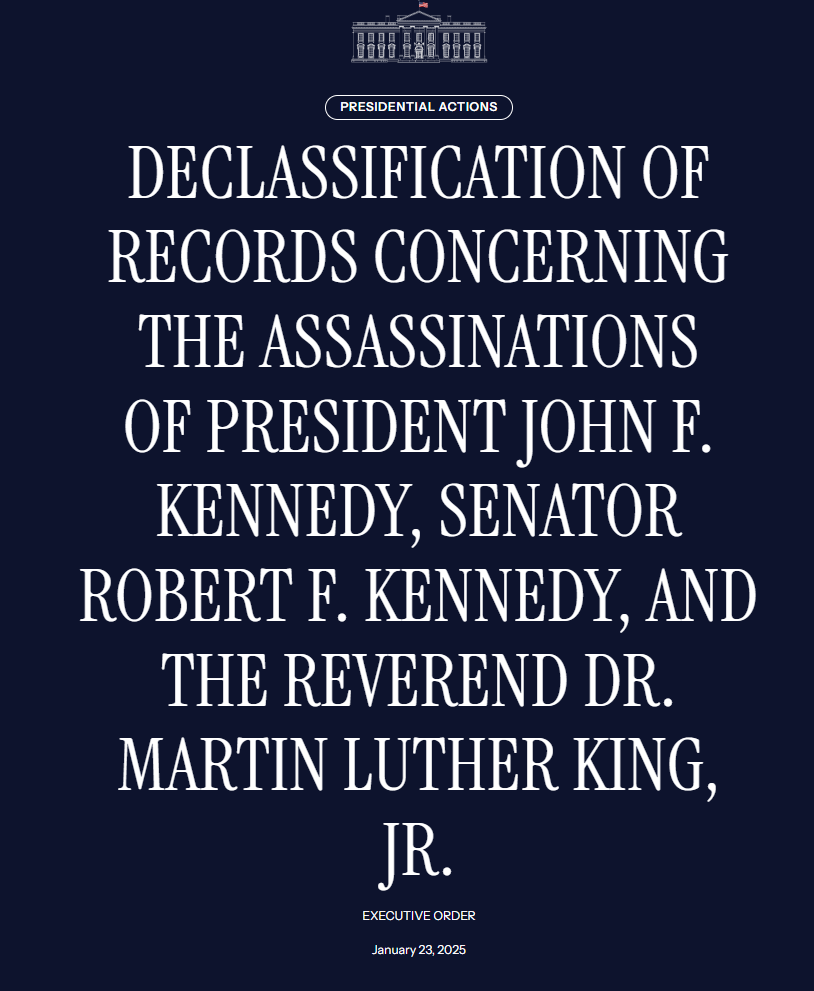President Donald Trump has signed an executive order to declassify the remaining federal records related to the assassinations of President John F. Kennedy (JFK), Senator Robert F. Kennedy (RFK), and Reverend Dr. Martin Luther King Jr. (MLK). This announcement marks a significant step toward transparency in uncovering details surrounding these high-profile killings, which continue to spark public fascination and conspiracy theories decades later.
What Is Declassified Information?
Declassification involves the release of previously restricted government documents that were once withheld from public access due to concerns over national security, intelligence sources, or diplomatic relations. By declassifying these records, the government aims to promote accountability and provide clarity on historical events.

The JFK files have been at the center of this debate, as many of the records have already been disclosed—most recently under the Biden administration, which released 13,000 documents. However, some files have remained heavily redacted or completely classified, fueling speculation about what the government is withholding.
Revisiting the Assassinations
When Was JFK Killed?
President John F. Kennedy was assassinated on November 22, 1963, in Dallas, Texas, as his motorcade passed through Dealey Plaza. Lee Harvey Oswald was arrested for the crime but was murdered by nightclub owner Jack Ruby two days later. The Warren Commission concluded that both Oswald and Ruby acted alone, but doubts and alternative theories have persisted, with some pointing fingers at the CIA, the Mafia, or foreign governments.
When Was RFK Killed?
Senator Robert F. Kennedy, younger brother to JFK, was assassinated on June 5, 1968, in Los Angeles after celebrating a victory in the California Democratic primary. He was shot in the kitchen of the Ambassador Hotel by Sirhan Sirhan, who remains in prison. However, RFK Jr. and others have raised questions about whether Sirhan was truly responsible or if others played a role in his father’s death.
When Was MLK Killed?
Dr. Martin Luther King Jr., a leader of the Civil Rights Movement, was killed on April 4, 1968, in Memphis, Tennessee. He was shot on the balcony of the Lorraine Motel while preparing for a dinner meeting. James Earl Ray confessed to the assassination but later recanted, claiming he was set up. Allegations of involvement by figures linked to organized crime, the FBI, and other entities have fueled continued suspicion.
What Could the Files Reveal?
The newly declassified JFK, RFK, and MLK files could shed light on unanswered questions, such as:
- The true motivations and potential conspirators behind the assassinations.
- Possible links between government agencies and the individuals involved.
- Insights into Cold War-era intelligence operations and geopolitical tensions.
While historians and researchers hope these files provide definitive answers, others caution that the new documents may raise more questions than they resolve.
Trump’s Executive Order To Declassification
On January 23, 2025, Trump signed an executive order mandating the review and release of remaining documents related to the assassinations of JFK, RFK, and MLK. The order establishes clear deadlines:
- JFK Files Released: Agencies must present a plan for the full release of JFK assassination records within 15 days.
- RFK and MLK Files: Plans for declassifying these documents are required within 45 days.

“This is a big one. People have been waiting for decades. All will be revealed,” Trump said at the signing ceremony, emphasizing the importance of transparency. He also handed the signing pen to Robert F. Kennedy Jr., a vocal advocate for releasing these files and Trump’s nominee for Secretary of Health and Human Services.
The Fight for Full Transparency
Trump’s executive order builds on decades of calls for declassification. In 1992, the President John F. Kennedy Assassination Records Collection Act required all JFK-related documents to be released by 2017 unless deemed too sensitive for national security. Trump, during his first term, delayed the release of some files at the request of intelligence agencies, a decision echoed by subsequent administrations, including Biden’s.
As of 2023, the National Archives reported that 99% of JFK-related records had been made public, but the remaining 1% includes key information still deemed sensitive. Critics argue that withholding these details prevents closure and fuels conspiracy theories.
Challenges to Full Disclosure
Although Trump’s order sets strict timelines, obstacles remain. Intelligence agencies like the CIA and FBI have resisted the release of certain documents to protect confidential sources and operational methods. These agencies argue that revealing such information could harm national security or endanger lives.
Moreover, the actual release of the files could take months, even years, as government officials carefully review and redact sensitive portions. Skeptics worry that redactions might still leave key questions unanswered.
The push to release the remaining assassination records marks a pivotal moment in the pursuit of government accountability. By declassifying these documents, Trump’s executive order seeks to provide long-overdue answers to some of the most debated events in American history.
As deadlines approach for the release of these files, the world will be watching to see what revelations emerge from the declassified JFK files and related documents. These records hold the promise of reshaping our understanding of events that forever changed the course of American history.


